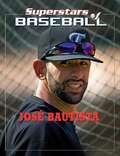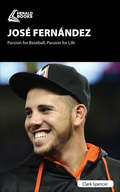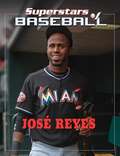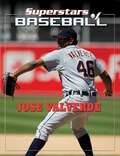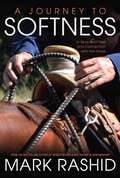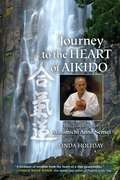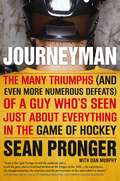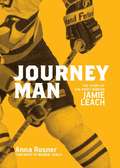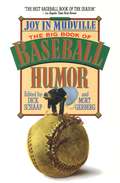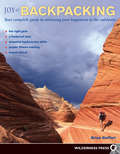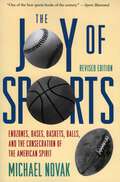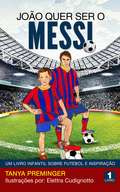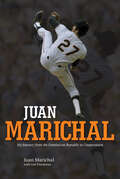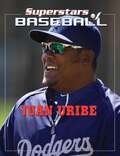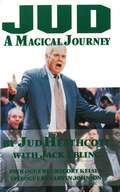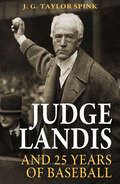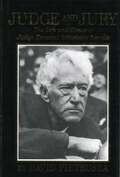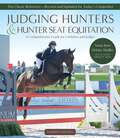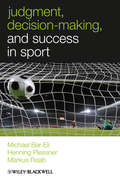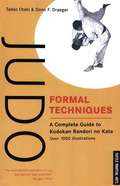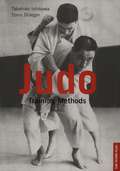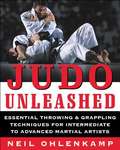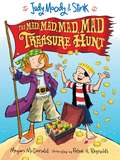- Table View
- List View
José Bautista (Superstars of Baseball)
by Tania RodriguezJosé Bautista has only been in the Major Leagues a few years. But he's already had an amazing career in baseball. He's played in the All-Star Game, he's won awards, and he's made millions of dollars. Bautista even hit more than 50 home runs in one season! Fans love to see him knock a ball out of the park! Learn how Bautista spent years in the minor leagues before making it to the Majors. Discover the story of how Bautista never gave up on his dream of playing in the Major Leagues, even when things were tough.
José Fernández: Passion for Baseball, Passion for Life
by Clark SpencerThe inspiring life and career of the Miami Marlins’ pitcher, the youngest MLB All-Star in team history, who died in a tragic boating accident in 2016. <P><P>In August 2016, José Fernández’s girlfriend, Maria Arias, presented him with a special cake at a family dinner to celebrate that they were going to have a baby. For Fernandez, becoming a father marked a new milestone in a young life that had already been brimming with milestones: fleeing Cuba multiple times before making it to freedom in the United States; drafted by the Miami Marlins in the first round in 2011; making the 2013 and 2016 All-Star teams; winning the National League Rookie of the Year award in 2013, and becoming a US citizen in 2015. <P><P>Suddenly, early in the morning of September 25, his life came to a tragic end in a boating crash that left his family, friends, and the baseball world devastated. This book is a Miami Herald tribute to baseball’s unforgettable young pitching sensation and lover of life.
José Reyes (Superstars of Baseball)
by Tania RodriguezJosé Reyes has become one of baseball's biggest stars. He has led the National League in stolen bases and batting average. He has played in the All-Star Game, won awards, and made millions of dollars. His time in the Major Leagues has been a dream-come-true for the Dominican player. Learn about the life of one of baseball's newest stars. Read how he worked his way through the minor leagues to play for the New York Mets. Discover the story of one of baseball's superstars!
José Valverde (Superstars of Baseball)
by Tania RodriguezToday, José Valverde is one of baseball's best relief pitchers. Valverde has pitched in the All-Star game. He's won awards and made millions of dollars. Valverde even had a perfect regular season in 2011! Valverde's path to finding success in the MLB was a long one, though. He had to work hard to make it to where he is today. Read how Valverde started playing baseball thanks to his uncle, former MLB pitcher José Mercedes. Learn about Valverde's success in the minor leagues and find out how he became one of baseball's best pitchers.
Journalistisches Handeln in der Skandalberichterstattung: Eine handlungstheoretische Analyse aus der Perspektive von Politik- und Sportkommunikatoren
by Natascha WehlischSkandale sind zweifellos ein wichtiges Korrektiv innerhalb demokratischer Gesellschaften. Gleichzeitig kritisieren Sozialwissenschaftler den verstärkten Einsatz von Skandalisierungen als Mittel im massenmedialen Aufmerksamkeitswettbewerb sowie beobachtbare Personalisierungs- und Boulevardisierungstendenzen der Berichterstattung, die langfristig zu dysfunktionalen Effekten in der Bevölkerung wie einem Überdruss an Skandalen, Abstumpfungseffekten und gesellschaftlicher Instabilität führen können. Die Autorin zeigt aufbauend auf einem strukturell-individualistischen Modell sowie leitfadengestützten Experteninterviews mit Journalisten verschiedener Mediengattungen und Ressorts, wie unterschiedliche interne und externe Bedingungen die Handlungsentscheidung von Journalisten in Skandalsituationen beeinflussen und wie Einzelhandlungen verschiedener Akteure in ihrer Aggregation zu unerwünschten gesellschaftlichen Folgeeffekten führen können. Die Ergebnisse der Arbeit sollen zu einer Versachlichung der Diskussion beitragen und negativen Folgeeffekten zunehmender medialer Skandalisierung durch eine Sensibilisierung der Akteure entgegenwirken.
Journey of a River Walker: Paddling the St. Johns River (Wild Florida)
by Ray WhaleyWhen Ray Whaley set out to accomplish his bucket-list goal of kayaking the length of the St. Johns River, it didn’t take long for him to realize he was in over his head. The longest river in Florida, stretching 310 miles between Vero Beach and Jacksonville, the St. Johns had been paddled in its entirety by only a handful of people. Whaley found himself blazing his own trail on an exciting and unexpected adventure. In Journey of a River Walker, Whaley tells the whole story of his experience, from his preparations beforehand to the techniques he learned along the way to his daily escapades and discoveries on the water. Learning from Whaley’s recommendations, along with his mistakes and close calls, readers will gain valuable knowledge that will help them in planning their own paddling trips. Whaley’s journey also highlights the delicate ecosystem of the river and the importance of conserving its environment, raising awareness of the fragile yet critical link between humans and nature. A volume in the series Wild Florida, edited by M. Timothy O’Keefe
Journey to Softness
by Mark RashidInternationally acclaimed horse trainer Mark Rashid shares and analyzes the remarkable events, quiet moments, and humbling stumbling blocks that-looking back-he can identify as significant in his personal journey to finding softness with both horses and people. Softness, via what many in the horse world today might refer to as feel, begins, Rashid says, with one simple truth: It's not about what we do that starts us on the path to softness, but rather, it's what we don't do. Softness is having the sensitivity we need in order to feel when and if the horse tries to give. It is about developing the kind of awareness and feel it takes to know when we are working against our horses, rather than with them. In these forthright stories, readers get a glimpse of a life that has produced a man known for his ability to solve difficult problems with communication rather than force, as well as methods and techniques gleaned from decades of work with horses, horse people, and martial artists.
Journey to the Heart of Aikido: The Teachings of Motomichi Anno Sensei
by Linda Holiday Motomichi AnnoJourney to the Heart of Aikido presents the teachings of Motomichi Anno Sensei, one of the few remaining direct students of Morihei Ueshiba, the legendary founder of Aikido. After a lifetime of practice and teaching in Japan, the United States, and Europe, Anno Sensei conveys through his teachings Aikido's essential spirit of love, harmony, gratitude, and purification with simple authenticity and eloquence. Author and translator Linda Holiday--herself a senior instructor of Aikido--brings to life the intimacy of this communication through translated discourses on the deep practice of Aikido and candid dialogues between Anno sensei and Western students. Journey to the Heart of Aikido includes Linda Holiday's vivid account of her adventure as a young woman studying Aikido in the mystical region of Kumano, Japan, in the 1970s, and a poignant telling of Anno sensei's life and his first-hand experience of training with Aikido's founder. An essential resource for the global Aikido community, Journey to the Heart of Aikido also offers spiritual teachings relevant to all contemporary seekers, touching a wide range of themes such as the meaning of martial arts, the integration of body and spirit, the truth of interconnectedness, and the practice of peace, offering all readers insight into the profound spiritual questions at the heart of life.From the Trade Paperback edition.
Journeyman
by Sean ProngerAll young hockey players dream of one day playing in the NHL, but kids should be careful what they wish for. They may make it to the pros, as Sean Pronger did, only to end up playing for sixteen teams over eleven seasons. They may end up on a team with a player like the Great One but skate on his line only in practice, when the bona fide first-line centre has the flu. And they may end up drinking champagne-but only because their little brother has won the Stanley Cup. Anyone who’s gotten to the NHL the hard way has a story to tell. No one understands the game better than the guys on the fourth line who fight for their jobs every night. They know all too well what it’s like to watch from the press box or, worse, to be sent to the minors or traded. Sean Pronger has seen it all. He’s played for legendary coaches like Pat Burns and gone head-to-head with Doug Gilmour and Steve Yzerman in the faceoff circle. He was on the ice for perhaps the most notoriously violent attack in recent hockey history. While playing in the minors in Winnipeg he guzzled beer in an ice-fishing hut with grizzled veterans like John MacLean, and he caused international incidents with Doug Weight while playing in Europe. But none of that went to his head. Full of hilarious stories and self-deprecating jokes, Journeyman is in the end a story not only about achieving a dream, but about realizing you’ve achieved it. .
Journeyman: The Story Of NHL Right-winger Jamie Leach
by Reggie Leach Anna Rosner"Journeyman is a first-person biography of Ojibwe right-winger Jamie Leach, son of the legendary NHL superstar Reggie Leach. Follow the fascinating hockey trajectory from his childhood years watching his father play for Philadelphia Flyers, to Jamie's first goal in the NHL. Journeyman touches on Jamie's summers on Lake Winnipeg, the World Junior Hockey Championships, his life in the minor leagues, and his eventual draft into the NHL as a Pittsburgh Penguin. Discover how some of hockey's biggest stars such as Bobby Clarke, Jaromir Jagr, and Mario Lemieux influenced Jamie's life. Written in close consultation with Jamie and his mother, readers will learn about the struggles Jamie conquered, including his father's alcoholism and his own crippling self-doubt. A story of determination, heartbreak and perseverance."--
Joy In Mudville
by Dick Schaap Mort GerbergA comic lineup of stories, essays, cartoons, and more, from Lardner and Runyon to Philip Roth, Charles Addams to Charles Schulz, plus dozens of other funny fans. "The best baseball book of the season." -- Los Angeles Times Book Review.
Joy of Backpacking
by Brian BeffortA comprehensive guide covering every aspect of how to backpack--from planning a first trip to advanced wilderness travel. For those new to the activity, longtime backpacker and author Brian Beffort covers the fundamentals, with sections on trip planning, gear, backcountry nutrition and cooking, navigation, and other essential wilderness skills. You will also learn what to expect on the trail and in camp, and how to stay safe with first aid, weather preparedness, and more. For experienced packers, this book is filled with practical tips and inspired ideas on how to update and refine your approach to backpacking based on trends in lightweight gear, high-tech gadgets, changing wilderness rules, and increasing opportunities for wilderness travel around the world.
Joy of Sports, Revised: Endzones, Bases, Baskets, Balls, and the Consecration of the American Spirit
by Michael Novak"...an exhilarating exercise full of uncanny insights..." —PublishersWeekly
João quer ser o Messi: Um livro infantil sobre futebol e inspiração (João quer ser o Messi #1)
by Tanya PremingerVencedora do MOM'S CHOICE AWARDS 2018 - Honrando Excelência Mundialmente Confiável por Pais e Educadores João, um aluno de segundo ano imaginativo e apaixonado por futebol, quer ser o grande astro do futebol Leo Messi, e está a trabalhar duro para o seu objetivo. Ele luta contra medos, intimidações, lição de casa e de dormir em busca de seu sonho de se tornar o melhor jogador de futebol do mundo. Um livro infantil e envolvente sobre futebol, prática e inspiração. Belas ilustrações de Elettra Cudignotto. Citação do livro: "Demorei 17 anos e 114 dias para ser um sucesso instantâneo". - Lionel Andrés Messi Este livro de capítulos faz parte de uma série, mas funciona facilmente como um livro independente. É adequado para crianças entre os 6 e os 10 anos (nível de leitura 3, do 1º ao 4º ano). Ideal para os primeiros leitores ou para ser lido em voz alta por um dos pais como uma história para dormir.
Juan Marichal: My Journey from the Dominican Republic to Cooperstown
by Lew Freedman Juan MarichalThe groundbreaking superstar tells his story: “To look at the MLB career of Hall of Fame pitcher Marichal is to look at another era . . . a solid hit.” —Library JournalIn a decade that featured such legendary hurlers as Sandy Koufax, Bob Gibson, Don Drysdale, and other Hall of Famers, no pitcher won more games than Juan Marichal in the 1960s. His unique high-kick pitching style was imitated by kids from New York to San Francisco to Santo Domingo, and is immortalized in a bronze statue outside of the Giants’ current ballpark. Marichal was the first Dominican-born player to play in an All-Star Game and the first elected to the Baseball Hall of Fame, and he won more games than any of his countrymen. And while Dominican and other Latino players have come to dominate many aspects of baseball in recent years, Marichal was a trailblazer in his day, entering the league at a time when Latin American players were routinely discriminated against, underpaid, and presented with numerous obstacles on their journey to the big leagues.Now, Marichal tells the story of his rise from living on a rural farm as a young boy in the Dominican Republic to his status as one of the greatest pitchers of all time. Along the way, he was enlisted by the son of the country’s dictator to play for the national team, was threatened at gunpoint to throw a game during a tournament in Mexico, fought homesickness as a minor leaguer in rural Indiana, and went head-to-head with some of the best pitchers and hitters the game has ever seen.For the first time, Marichal gives his perspective on life as a Latino ballplayer in the 1960s, describes the highs and lows of a sixteen-year major league career, and explores what the recent influx of Dominicans in the majors has meant to baseball and to his home country—and also offers reflections on lingering stereotypes, the impact of steroids, and the general state of the game in the twenty-first century.
Juan Uribe (Superstars of Baseball)
by Tania RodriguezJuan Uribe has come a long way from his roots in the Dominican Republic. He's played in two World Series, and he earns millions of dollars every year. But it's his roots that still make him strong. Uribe is proud of his homeland--and his homeland is proud of him! Read about Juan Uribe's life. Find out what it takes to be a baseball superstar!
Jud: A Magical Journey
by Jud HeathcoteWith a career record of 420-273 and an MSU mark of 340-220 Jud Heathcote has more than stood the test of time and at retirement was the fifth-winningest coach in the Big Ten History. He directed the Spartan program to the 1979 NCAA Championship, three Big Ten titles, and seven of the Spartans' 20-win seasons.
Judge Landis and 25 Years of Baseball
by J. G. Taylor SpinkJudge Landis and 25 Years of Baseball, first published in 1947, is a look at the career of Judge Kenesaw Mountain Landis, a federal judge and professional baseball’s first commissioner, who served in that position for 25 years until his death in 1944. The book, authored by J. G. Taylor Spink, editor of the influential The Sporting News, also serves as a history of major league baseball at that time - the team owners, the players, the legal battles, and the scandals (including the infamous “Black Sox” scandal). Judge Landis’s decisive actions and iron rule over the game were largely responsible for restoring public confidence in the sport. Included are 5 pages of photographs.
Judge and Jury: The Life and Times of Judge Kenesaw Mountain Landis
by David PietruszaJudge Kenesaw Mountain Landis is most famous for his role as the first Commissioner ever to rule organized baseball. But before he came into his legendary position as baseball's final say, Landis already had built a reputation from his Chicago courtroom as the most popular and most controversial federal judge in World War I-era America. Judge and Jury is the first complete biography of the Squire, from the origins of his unusual name through his career as a federal judge and his clean-up after the infamous Black Sox scandal.
Judging Hunters and Hunter Seat Equitation
by Anna Jane White-MullinYour key to success in the hunter and equitation ring, from one of thesport&’sclassic judges and competitors, completely revised for today's rider.Revised and updated with the most current USEF rules and tests,Judging Hunters and Hunter Seat Equitationby Maclay winner and former R judge Anna Jane White-Mullin is the world&’s favorite book on how to judge hunter show competitions, and understand exactly how they are judged. This must-have resource gives anyone competing in or judging hunter or equitation classes the edge, with professionally reviewed and approved sections that examine:Conformation: structural composition; physical defects versus blemishes.Hunters Under Saddle and Over Fences: length of stride, frame, and straightness; rhythm, transitions, impulsion, and bending; locomotion and form faults; honest and dishonest horses.Equitation on the Flat and Over Fences: rider position; cadence, collection, and lengthening; approaching fences and in the air; USEF tests.Written with both the aspiring judge and the avid competitor in mind, the book offers invaluable explanations of what judges look for as well as the training methods necessary to accomplish the desired results. More than 100 color photographs with top equestrians in the tack demonstrate correct and incorrect positions in both horses and riders, sharpening the reader's eyes while also providing an unparalleled foundation of knowledge that makes self-correction in the saddle possible. In addition, readers will find a primer on both understanding and completing the Judge's Card, with explanations of numerical scoring, terminology, abbreviations, symbols, comments, and general impressions. This remarkably complete two-in-one reference can be the difference in your success, whether in the ring or in the judge&’s box.
Judgment, Decision-making and Success in Sport
by Henning Plessner Michael Bar-Eli Markus RaabJudgment, Decision-Making and Success in Sport presents a thorough overview and assessment of the study of Judgment and Decision-Making (JDM) in sports psychology, and represents an important source of information for those interested in the possible causes and reasons for success and failure in sport.The only book to apply the principles of JDM to sportApplies theory to practice by looking at problems of athletes, coaches, and referees and providing recommendations for dealing with themOffers an overview of current JDM researchUseful for psychologists, physical education teachers, sports scientists, and researchers in this field
Judo Formal Techniques
by Donn F. Draeger Tadao OtakiThis comprehensive manual on the basic formal techniques of Kodokan Judo, the Randori no Kata, provides the fundamental instruction in nage and katame no kata (throwing and grappling) that is essential to effective judo. With over 600 photographs and 400 drawings, Judo Formal Techniques gives complete step-bystep descriptions of the roles of both training partners. In addition to throwing and grappling, the important transitional movements, as well as grips, stances, and postures, are explained. The authors have, by studying the published and unpublished personal writings of Jigoro Kano (the founder of Kodokan Judo), been able to recapture the original spirit and intent of the judo kata, which they present in the standard Kodokan versions, as refined by generations of master judoka.Expertly written and richly illustrated, Judo Formal Techniques is the classic "kata bible" for judo student and instructor alike and a tremendous resource for martial arts practitioners outside the realms of judo and jujutsu.
Judo Training Methods
by Donn F. Draeger Takahiko IshikawaA product of over over twenty years of exhaustive research, Judo Training Methods is a comprehensive examination of the martial sport of judo. Although the examples are geared toward judo, the training and conditioning methods set out are valuable for all martial artists and athletes, whatever their art or sport. This classic work, which has long been unavailable, is still a timely and valuable read. Judo Training Methods is an "encyclopedia of judo" covering not only techniques and training met hods but also dojo etiquette, tournament rules, and promoti on requirements. The text features over 1,000 photos and 200 conditioning exercises.
Judo Unleashed: Essential Throwing and Grappling Techniques For Intermediate To Advanced Martial Artists
by Neil OhlenkampHundreds of full-color throws and grabs make this the black belt of instructional judo books In Judo Unleashed, master coach Neil Ohlenkamp brings together the form, practice, and grace of this venerable sport in an all-inclusive handbook. From philosophical and technical foundations through advanced grappling and self-defense techniques, this authoritative guide, with 350 color photos, covers all the bases you need to refine your technique and gain a deeper understanding of this increasingly popular martial art.
Judy Moody & Stink: The Mad, Mad, Mad, Mad Treasure Hunt
by Megan McdonaldAvast, ye scum buckets and scallywags! Judy and Stink co-star in their second full-color adventure - crawling with pirates and puzzles, carbuncles and chuckles. As soon as the Moody family drops anchor on "Artichoke" Island, they are greeted by Cap'n Weevil, a one-eyed buccaneer with a scraggly beard and a secret treasure map. Before you can say "Davy Jone's Locker," Stink and Judy are racing across the island in search of gold. But - shiver me timbers! - they're not the only salty dogs lookin' for loot. Can Mad Molly O'Maggot and Scurvy Stink beat out their rivals, Tall Boy and Smart Girl? Can they find the hidden clues, crack the secret codes, and solve the tricky puzzles before time runs out? Aaarr!
